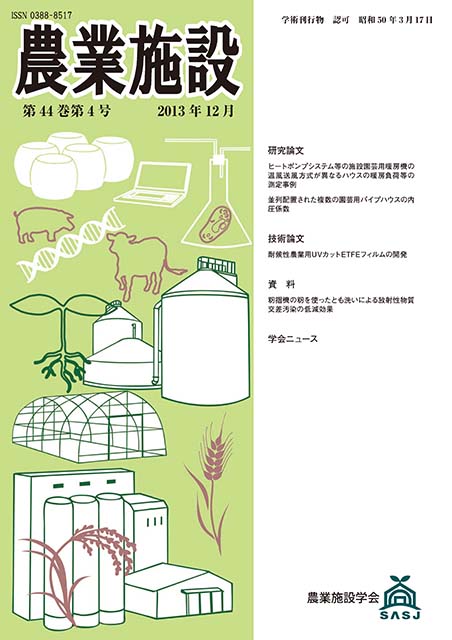All issues

Volume 44 (2013)
- Issue 4 Pages 167-
- Issue 3 Pages 100-
- Issue 2 Pages 51-
- Issue 1 Pages 1-
Volume 44, Issue 4
Vol. 44, No. 4 (Ser. No. 139)
Displaying 1-3 of 3 articles from this issue
- |<
- <
- 1
- >
- >|
-
Yasushi UEMATSU, Nam-Seok KIM, Hideki MORIYAMA, Sadanori SASE2013 Volume 44 Issue 4 Pages 167-173
Published: 2013
Released on J-STAGE: September 07, 2023
JOURNAL OPEN ACCESSThe internal pressures induced in two or three pipe-framed greenhouses arranged in parallel are numerically simulated by using the time history of external pressures measured at the locations of gaps existing in the walls of pipe-framed greenhouse in a turbulent boundary layer with a 1:40 scale model. The distance between greenhouses is varied from 0.25 H to 1.0 H, with H being the ridge height. The results indicate that the internal pressure coefficient is affected by many factors; i.e., the location of greenhouse under consideration, distance between greenhouses and wind direction. In our previous papers, we first proposed models of the external pressure coefficient and the peak external pressure coefficient for designing the structural frames and cladding, respectively, based on the results for an isolated model. Then, we proposed models of the internal pressure coefficient and the peak internal pressure coefficient to be combined with those of the external pressure coefficients. The present paper discusses the application of these models to the plural greenhouses arranged in parallel.View full abstractDownload PDF (2152K) -
Hiroshi ARUGA, Yasuyo NISHIMURA, Yasufumi FUKUMOTO2013 Volume 44 Issue 4 Pages 174-183
Published: 2013
Released on J-STAGE: September 07, 2023
JOURNAL OPEN ACCESSDevelopment of the UV-blocking ETFE film (ETFE is a fluoropolymer) for greenhouses is examined, focusing on the production process sequence from synthesizing the filler, to treating the surface, forming the dispersive compounding, extruding the film and applying the anti-drip coating. The weathering resistance of the film is also discussed. The new UV-blocking filler (CeO2: SiO2 = 40:60), the treatment agent for dispersion, and the processing method that was devised for the ETFE resin were developed. This UV-blocking film is transparent and after 12 years, the deterioration in UV-blocking function was less than 4% and its mechanical property remained almost unchanged. That success is attributable to the technology used in synthesizing silica-coated cerium dioxide in the solution layer for transparency, performing the silica-coating process in the solution layer for weathering resistance, and developing the dispersion technique so that the filler can be dispersed uniformly in the ETFE resin.View full abstractDownload PDF (1948K) -
Yasuyuki HIDAKA, Takahiro NODA, Kenta SHIGEMATSU, Yosuke KUBOTA, Takas ...2013 Volume 44 Issue 4 Pages 184-190
Published: 2013
Released on J-STAGE: September 07, 2023
JOURNAL OPEN ACCESSIn order to reduce the radioactive cross contamination in a husker, we investigated the “decomposition cleaning of a husker” and the “washing with rough rice” technique. Washing the husker with rough rice involves supplying 40 kg of rough rice, carrying out circulation inside the husker for about 3 minutes, and discharging. Although investigation showed that the caesium concentration in the brown rice was reduced through decomposition cleaning, the reduction effect was dependent on the early contamination grade. It was shown that decomposition cleaning was not a perfect method for preventing cross-contamination because one example of brown rice was found that failed to meet the food safety standards (100 Bq/kg). The examination of the “washing husker with rough rice” technique showed that the caesium concentration of brown rice was reduced to 1/10 from the early stages of husking. This result was not influenced by the initial contamination of the husker, and the resulting caesium concentration of the brown rice was below the regulation value. For this reason, we concluded that washing a husker with rough rice is an easy and positive method for preventing radioactive cross contamination. However, since the caesium concentration in the residue inside the husker is high, for cross contamination recurrence to be prevented it is necessary to remove the residue inside the husker.View full abstractDownload PDF (1735K)
- |<
- <
- 1
- >
- >|